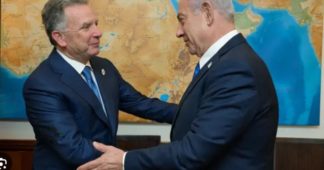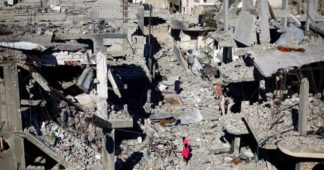By Qassam Muaddi
July 26, 2025
The U.S. has pulled out of the ceasefire talks between Israel and Hamas as Trump says that Hamas “didn’t really want to make a deal,” despite reports that its latest proposal was “better” than the one it had presented earlier in the week.
The U.S. envoy to the Middle East, Steve Witkoff, said on Monday that the U.S. will consider “alternative options” to negotiating with Hamas following the breakdown of ceasefire talks between Israel and the resistance group. Witkoff’s statements came as part of his announcement of Washington’s withdrawal from the talks in Qatar, only a day after Hamas presented its response to the latest Witkoff proposal.
Witkoff’s statement that the U.S. would find another way of securing “stability” in Gaza and the release of Israeli hostages in the Strip was later backed with a similar statement from President Trump, who said on Friday that Hamas “didn’t really want to make a deal.”
Trump added that Hamas leaders “know what happens after we get the final hostages, and so they didn’t want to make a deal.” Trump also said that Hamas “want to die” and that Israel has to “fight and finish the job.”
On Thursday, Axios’s reporter in Israel quoted an unnamed Israeli official as saying that Hamas’s response to the latest deal proposal was “better than the one Hamas gave on Tuesday and was rejected.” Earlier this month, during the series of back-and-forth proposals and counter-proposals, the Israeli daily newspaper Yediot Ahronot quoted Israeli military officials as saying that Hamas’s response “could be built upon.”
Also on Thursday, Israeli Prime Minister Benjamin Netanyahu called the Israeli negotiating team back to Israel. Later, the Israeli government later said in a statement that the ceasefire talks did not collapse, and that the negotiating team was called back to Israel for consultation purposes.
Witkoff’s and Trump’s surprising declarations on Friday came amid reports about progress being made in the ceasefire talks. Differences remained over issues concerning the Israeli army’s withdrawal lines and the mechanisms of the entry of humanitarian aid and its distribution.
According to reports, the latest Hamas response included modifications to two clauses relating to Israeli withdrawal and aid distribution, including new lines for Israel’s military withdrawal up to 1,200 meters from the Philadelphi Corridor, the militarized area that Israel created along Egypt’s border. Hamas’s response also included splitting aid distribution between international organizations, the UN, and the U.S.-Israeli Gaza Humanitarian Foundation (GHF).
Late on Friday, the foreign ministry of Qatar said in a statement that “suspending talks for consultation before resuming dialogue is considered a normal thing in the context of complicated negotiations.” Qatar’s foreign ministry also said that “Qatar and Egypt continue to mediate in order to reach a deal that guarantees the safety of civilians and the exchange of prisoners.” The statement pointed to “progress in the talks achieved in the past three weeks.”
Israel’s previous violation of the ceasefire
Israel and Hamas had reached a ceasefire deal shortly after Trump assumed office, under reported pressure from Witkoff on Israeli officials. According to the deal, both parties were supposed to move into talks over the final stage of ending the war after a 60-day ceasefire, during which Hamas would release all remaining civilian captives in Gaza, and Israel would release hundreds of Palestinian prisoners and detainees. However, Israel refused to move to the final stage of the talks, which left the status of the entire deal uncertain.
Israel wanted to prolong the first stage of the deal by extending the ceasefire and having more prisoner exchange batches, and therefore more Israeli captives released. Hamas demanded that in the final stage, international guarantees would be given to ensure that Israel would not resume its attacks on Gaza after the release of the last Israeli captives.
Israel finally broke the ceasefire on March 18, launching a series of bombings on the Gaza Strip that killed 400 Palestinians, including many children, in the first moments of its attacks across the Strip. Since then, Israel has imposed a total blockade on the entry of food, medicine, and other humanitarian aid to the Strip.
Later, Israel introduced the GHF to distribute aid through four distribution points, in the southern and central Gaza Strip, instead of the UN ‘s decades-old aid distribution system, which was able to deliver aid straight to every community.
The GHF distribution points became sites for shooting and killing Palestinian aid-seekers by Israeli forces, and according to several reports, by GHF staff as well. According to the Palestinian Health Ministry, more than 1,000 Palestinians have been killed at GHF centers while seeking aid since the U.S.-run and Israeli-backed distribution scheme began.
Israel claims that the GHF system aims to prevent the diversion of aid by Hamas, although evidence indicates that the looting of aid has been carried out by Israeli-backed gangs operating from Israeli-controlled militarized zones, including Rafah. Palestinians, the UN, and other parties insist that the UN-UNRWA system remains the only safe and efficient aid distribution system in the Strip. This issue has become a central sticking point in the stalled ceasefire talks.
We remind our readers that publication of articles on our site does not mean that we agree with what is written. Our policy is to publish anything which we consider of interest, so as to assist our readers in forming their opinions. Sometimes we even publish articles with which we totally disagree, since we believe it is important for our readers to be informed on as wide a spectrum of views as possible.











